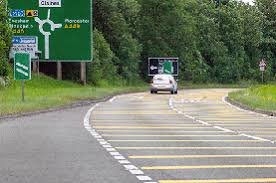Enhancing Road Safety with Yellow Traffic Lines: A Guide for Drivers

The Importance of Yellow Traffic Lines on Roads
Yellow traffic lines play a crucial role in guiding and managing traffic flow on roads. These bright markings are not just a splash of colour; they serve as essential communication tools for drivers, pedestrians, and other road users. Let’s explore the significance of yellow traffic lines:
Lane Separation
Yellow lines are commonly used to separate lanes of traffic moving in opposite directions. By clearly marking these boundaries, drivers can stay in their designated lanes, reducing the risk of head-on collisions and improving overall road safety.
No Overtaking Zones
Yellow lines are often employed to indicate no overtaking zones. These areas are typically deemed unsafe for passing due to limited visibility or potential hazards. By respecting these markings, drivers can avoid dangerous manoeuvres and prevent accidents.
Bus Lanes and Restricted Areas
In urban areas, yellow lines may designate bus lanes or restricted zones where only authorised vehicles can enter. These markings help regulate traffic flow, prioritise public transport, and enhance efficiency on busy city streets.
Pedestrian Crossings
Yellow zigzag lines near pedestrian crossings signal to drivers that they must not stop or park in these areas. This ensures a clear path for pedestrians and enhances visibility at crosswalks, promoting pedestrian safety.
School Zones
In proximity to schools, yellow zigzag lines are often used to indicate school zones where parking is restricted during certain hours. This measure aims to protect children entering or leaving school premises by maintaining clear sightlines for drivers.
Conclusion
Yellow traffic lines serve as vital visual cues that help regulate traffic behaviour, improve road safety, and enhance the overall efficiency of our transportation networks. By understanding and respecting these markings, drivers can contribute to creating a safer and more organised road environment for everyone.
Understanding Yellow Traffic Lines: Common Questions Answered
- What do two yellow lines mean?
- What are the three yellow lines on a road?
- What do yellow lines on the road mean?
- What is the difference between yellow and red lines?
- Can you stop on single yellow lines?
What do two yellow lines mean?
When encountering two yellow lines on the road, it typically indicates a no-overtaking restriction. These double yellow lines serve as a clear signal to drivers that overtaking is not permitted in either direction. The purpose of this road marking is to enhance safety by preventing risky passing manoeuvres in areas where visibility may be limited or hazards are present. It is important for drivers to adhere to these markings to maintain order on the road and reduce the risk of accidents.
What are the three yellow lines on a road?
When encountering three yellow lines on a road, it typically indicates a no-overtaking zone. The middle line is solid, indicating that overtaking is prohibited in both directions. The outer lines are usually broken, allowing vehicles to cross them for turning or entering driveways but still maintaining the no-overtaking restriction. These markings are designed to enhance safety by preventing risky overtaking manoeuvres in areas where visibility or road conditions may pose hazards. Drivers should always adhere to these yellow line markings to ensure safe and orderly traffic flow on the road.
What do yellow lines on the road mean?
Yellow lines on the road serve as important visual indicators for drivers, pedestrians, and other road users. In the UK, yellow lines typically signify restrictions or guidelines that must be followed to maintain safety and traffic flow. These markings commonly indicate no parking zones, loading restrictions, bus lanes, or areas where overtaking is prohibited. By understanding and adhering to the meanings of yellow lines on the road, motorists can navigate effectively and contribute to a safer road environment for all.
What is the difference between yellow and red lines?
When it comes to road markings, understanding the difference between yellow and red lines is essential for safe and lawful driving. Yellow lines typically indicate lane separation, no overtaking zones, bus lanes, pedestrian crossings, and restricted areas. On the other hand, red lines are commonly used to denote clearways where stopping or parking is strictly prohibited at all times. While yellow lines focus on traffic management and guidance, red lines emphasise restrictions and enforcement to maintain traffic flow and safety on the roads. By recognising and adhering to the distinctions between yellow and red lines, drivers can navigate roads more effectively while promoting overall road safety for themselves and others.
Can you stop on single yellow lines?
One frequently asked question regarding yellow traffic lines is whether it is permissible to stop on single yellow lines. In the UK, the general rule is that parking or waiting on a single yellow line is not allowed during the times specified on nearby signs. Single yellow lines typically indicate restricted parking hours, often during peak traffic periods or specific times of the day. It is important for drivers to carefully check and adhere to any accompanying signage to avoid potential fines or penalties for parking violations on single yellow lines.
